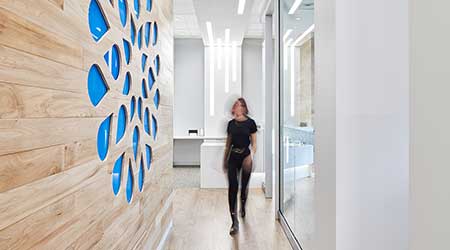
Lease Flexibility Will Be Crucial in Future Workplace
May 25, 2021
For many companies, the workplace of the future is inextricably tied to the length of their lease. If a company has already committed to a lease that runs for another 10 to 15 years, they are less likely to make wholesales changes because those are capital expenses, says Vincent Ng, director of interior design for HOK. Companies that have more space than they need are considering subleasing those floors, he says. Those decisions are being driven by the flexibility companies are anticipating they’ll need as workers return to offices, Ng says.
“Most people know the workplace won’t be the way it was before, and we just spent a year and a number of months demonstrating and proving that people don’t have to be in the office every day, so now there is momentum in shifting to a hybrid working environment,” Ng says. “So if you can have people that return to the office part of the week or a couple of days a week, then we can assign less square footage for the same number of people. The real driver is the savings in real estate costs.”
The fact that companies are questioning the need and the amount of real estate needed is natural because real estate is the second or third largest item on a profit and loss statement, right behind salaries, benefits, and sometimes information technology, says Steven Steinmeyer, senior managing director at JLL. There are chief financial officers looking around, seeing no one in the office and yet knowing that work is getting done, he says.
“We always recommend to clients, at the expiration of lease or some milestone, to challenge themselves as to how to create and how better to use the office to be better productive,” Steinmeyer says.
Companies that are committed to leases and which don’t have a significant amount of real estate are asking how they can modify the workplace so that it better suits the functions that are happening in the office, Ng says. If a company is rethinking the space it has, now is the time to say that “heads down” work can be done at home and not in the office, he says. When company executives consider what is missing from employees’ work lives right now, much of it is collaboration, face-to-face time, and spontaneous conversations – those relationships that people build with their colleagues, he says.
“So we need to focus on creating a workspace that supports that function,” Ng says. “The big picture is people are more open to alternative ways of working and now is the opportunity to seize that opportunity.”
To read this full article, titled “The Office of the Future Will Be Flexible,” check out our new premium content product, fnPrime. With fnPrime, you can get access to dozens of premium articles, webcasts, videos, and ebooks. And throughout the year, you’ll get discounts on events, and invites to exclusive member-only functions. Sign up today!
Next
Read next on FacilitiesNet












